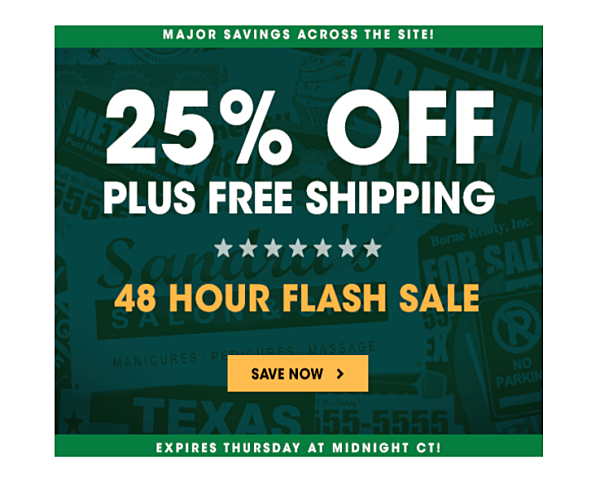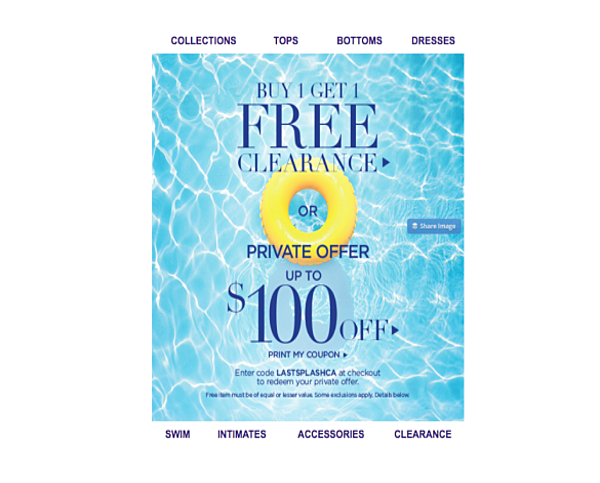Sales promotions are a quick and creative way for businesses to increase revenue and expand brand awareness.
Note the word “creative” in the previous sentence. Business owners shouldn’t be afraid to try different types of promotions, as there are many, and build on what works for them and tinker with what doesn’t. Mixing and matching also is encouraged.
Here are some effective types of sales promotions:
Flash sale
A flash sale offers savings on a product or service, but only for a short, predetermined period. Business owners use this deadline to act to create urgency, sometimes even mild panic among consumers. Phrases such as “Buy Now!” or “Act Fast!” or “Time is Running Out!” are effective in creating hype.
Because of this buzz, a flash sale can create a sudden awareness about a brand, and often attracts new leads. It also shortens the sales cycle, inspiring consumers to make a purchase when perhaps they would have otherwise waited or passed entirely. As a result, a flash sale can bring in a sudden burst of cash and produce additional revenue during a slow time of year.
Flash sales also are an effective way in which to sell products that are either somewhat outdated and/or out of season. If a small business can jettison products that have been collecting dust in storage, it can create space for newer inventory that's more popular with its customers.
The best flash sales are those that feature a limited quantity and that are offered for a very short period, according to a study by Experian Marketing Services, which found that 3-hour sales have the best transaction-to-click rates (59 percent higher than usual). The study also concludes that they’re best promoted via email, which drives 18 percent of flash-sale traffic. For a step-by-step look at setting up a flash sale email series, check out our e-book, Cash in a Flash.
Other keys to a successful flash sale include:
- Keep it simple
- Tailor it to a specific target market
- Promote it using marketing, social media and SEO
Buy 1, Get 1
Consumers have a very difficult time saying no to the notion of getting something for free.
That’s why a “Buy 1 Get 1” – or BOGO – sales promotion can be incredibly enticing and compelling. Think about it. Who doesn’t want to buy an item and get another item at no extra charge or, at worst, at a highly discounted rate? It’s seemingly a no-brainer. And it’s also a very straightforward approach, which consumers crave. In other words, there’s no fine print to worry about with a BOGO.
Per a survey conducted by AMG Strategic Advisors, 93% of consumers say they’ve taken advantage of “Buy 1, Get 1 Free” promotions. Furthermore, The AMG Shopper Panel reports that nearly 2 out of 3 shoppers prefer BOGO free promotions versus other promotions.
Like with all sales promotions, the ability to create the perception of getting a great deal is paramount. Consider the following: A small business offers a BOGO at 50% off a second product or service. In reality, it’s identical to offering 25% off the entire purchase of the 2 items. However, for the customer, the feel of getting half off the second item versus getting one-fourth off 2 items is much different. And therein lies the key to a BOGO – the perception.
BOGO promos are effective in moving inventory and creating cash flow. They can also introduce customers to offerings they wouldn’t have otherwise purchased. Plus, businesses can use a BOGO to dump overstocked inventory with a profit margin in mind.
Discounts
Considered by some to be the most popular type of sales promotion, discounts are a money-off offer applied to products or services, either online or in-store.
They work well because they trigger consumer spending and allow businesses to earn profit while sometimes getting rid of overstocked products.
Here are some common discount strategies:
Prepayment discount
Businesses sometimes offer a small discount to customers who can pay for their products or services in advance, perhaps even months before receiving them.
Bundled discount
Rather than lower the price of a product or service, businesses sometimes lower the price of multiple items purchased as a group, aka a “bundle.”
Volume discount
Businesses sometimes entice consumers to buy more units per order with a volume discount. It’s a good strategy for those wanting to clear inventory and/or increase the average value per order.
Seasonal discount
Sensing the public is in purchasing mode, wise businesses usually offer discounts during holidays, such as New Year’s Day and Valentine’s Day and Labor Day.
Not wanting to be forgotten or left behind, they also offer bargains during widely recognized discounting days, such as Black Friday and/or Cyber Monday. Business Wire reports sales on Cyber Monday 2018 hit $7.9 billion and $6.2 billion on Black Friday 2018.
Free shipping
Offering free shipping is another proven method to increase sales, but not charging for shipping can hurt a business if it’s working with low margins or if shipping costs aren’t factored into the price of the products. To ensure free shipping is wise, businesses can offer free shipping only when an order reaches a certain amount.
According to convinceandconvert.com, consumers are 4 to 5 times more likely to make a purchase if you offer free shipping. Moreover, studies show that people are more likely to buy something at $5 with free shipping and pass it up at $2.50 with a $2.50 shipping fee.

Coupons
Coupons are an established method to drive customers to your business, and, believe it or not, they’re thriving. Yes, some consumers still are clipping them from circulars, but a growing number are flashing them on their smartphones and/or typing coupon codes into online shopping carts more and more. In fact, according to readycloud, more than 25 million Americans use couponing apps to save money each month.
The advantages of offering coupons to consumers are numerous, including introducing new customers to your business and introducing new product lines. The key is to calculate whether the discount offered by the coupon will make a difference to your profit margin.
It’s worth noting that some businesses offer a coupon or gift card as part of a purchase. This is a win-win as the customer gets a chance to save money and the business gets a follow-up chance to make more money from that customer, as long as the discount offered via the coupon or gift card still allows for a profit margin.
Plus, there’s a nifty bonus for businesses: Per Finder.com, more than $45 billion "has been floating around in unused gift card balances" since 2005.
Gifts/samples
Never underestimate how much people love freebies! For example, go to a professional sports event on a night the home team is giving away a bobblehead doll of their star player. People will stand in line for hours to get their hands on 1 of those cute yet otherwise useless collectibles. Some will even beg for an extra for their nephew or niece who couldn’t make it to the game (wink, wink).
Better yet, go to a Costco on a Sunday afternoon and watch how people hover around those friendly folks serving up free samples of food products Costco just happens to sell. It’s a feeding frenzy! And why? Well, it’s not because that minuscule pig in a blanket is so tasty. It’s because there is no charge to eat it there at the end of Aisle 17. There is absolutely nothing for that consumer to lose, except for 15 seconds – or perhaps 30 if they choose to interact with the server.
Let’s face it, getting something for nothing is awesome for the consumer. On the flip side, the business handing out the freebie gets to entice customers to buy a product they may not have considered purchasing before. People like trying something before they commit to buying it. It’s wise to let them do so via a free sample.
Recurring sale
Recurring sales are all about training customers to react to a good deal when they see it. At the same time, they provide an exciting benchmark for the consumer to look forward to and create excitement and anticipation within an otherwise structured schedule.
For example, Nordstrom’s Anniversary Sale, which is spread out over 3 weeks every July/August, is 1 of the most highly anticipated shopping events of the year and a glowing example of a recurring sale done correctly. And here’s why: Instead of discounting its unwanted summer leftovers, the retailer instead marks down shiny new arrivals for fall (i.e., every fashion lover's favorite season).
It’s a bold strategy that works extremely well for Nordstrom. Small business owners should strive to create a similar phenomenon within their means.
“Nordstrom had a really revolutionary idea with discounting products at the beginning of the season,” said blogger Caitlin Covington, as quoted by Adweek.com. “All of the items are brand-new, and they’re automatically on sale, which makes it so much more exciting than if the products were to come out at a normal price and then be discounted later on.”
Tripwire
A tripwire is a low-priced offer and its sole purpose is to convert a prospect into a first-time buyer as quickly as possible. The thinking is that once a customer experiences the value in a business’s product or service, that customer will be more comfortable and more likely to make a bigger purchase from that company.
Quite simply, it’s all about a business building trust with a customer via an irresistible offer.
Tripwires are an effective sales promotion because they are so inexpensive. Most are priced between $5 and $25, and most consumers are willing to take a risk having deduced that at such a low cost, the offer is just too good to pass up.
The product or service offered as part of a tripwire promo usually is a “splinter “ of 1 of the business’s bigger core products. The goal in offering the splinter is to impress the consumer with the quality of the less impactful product and then get them to buy higher-priced products. Popular tripwire examples include a book, a webinar, a free or paid trial, or a software product, to name just a few.
A business often will lose money selling a tripwire product or service at such a low cost, but it must remember the ultimate goal, which is to get a paying customer in the mix to make an upsell or cross-sell. Remember, a tripwire promo is most effective in separating the “Just Lookers” from the “Buyers.”
Consider this eye-popping claim from powerdigitalmarketing.com: “People who purchased tripwires were 10 times more likely to purchase a core offer.”
Try free
14-day free trial. No credit card required.








